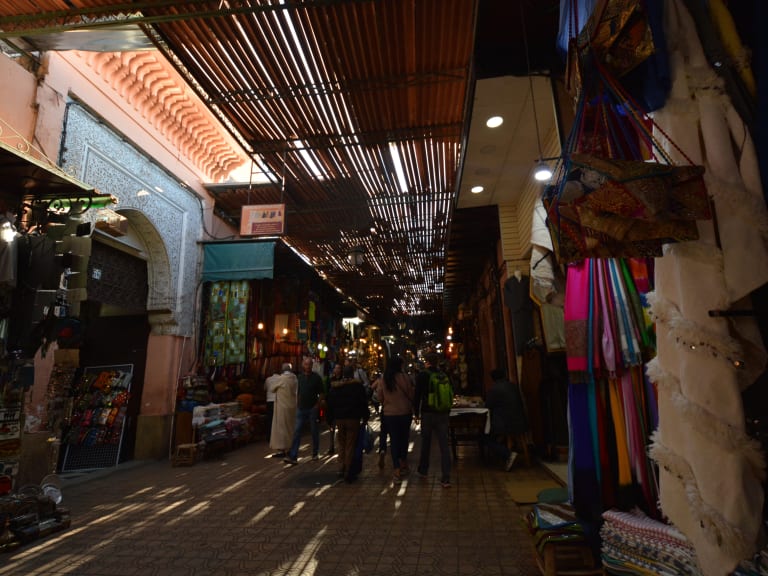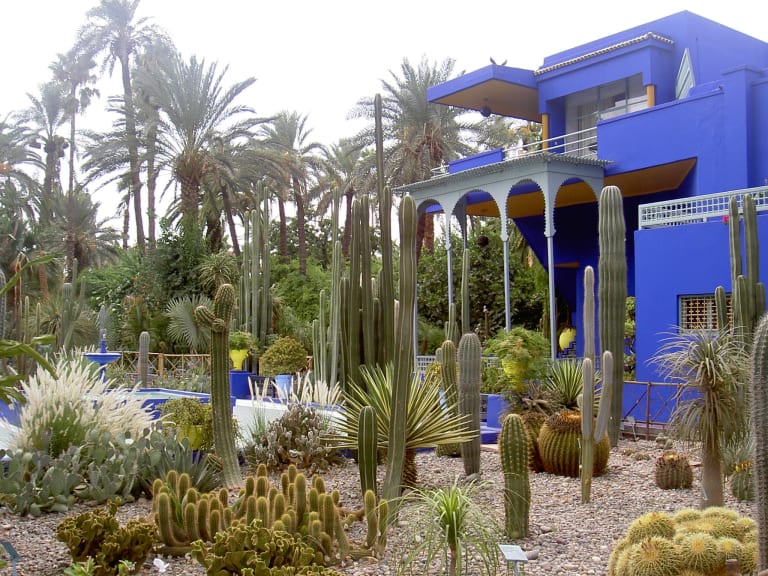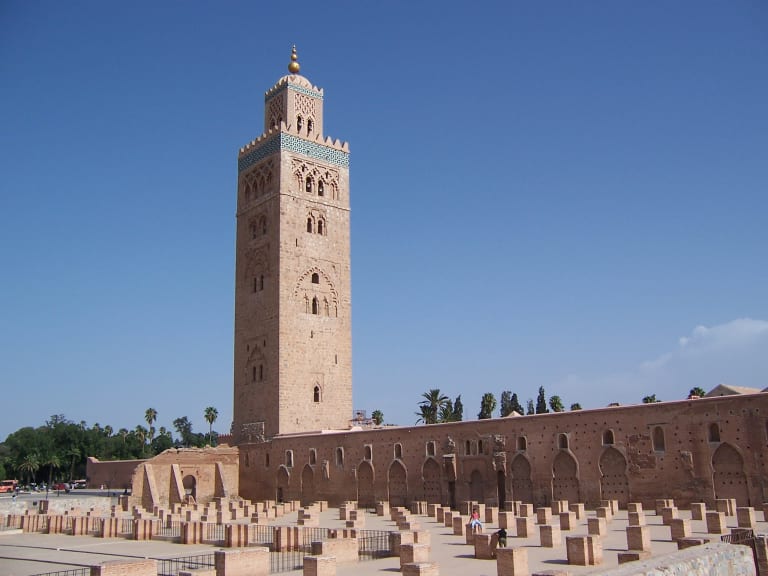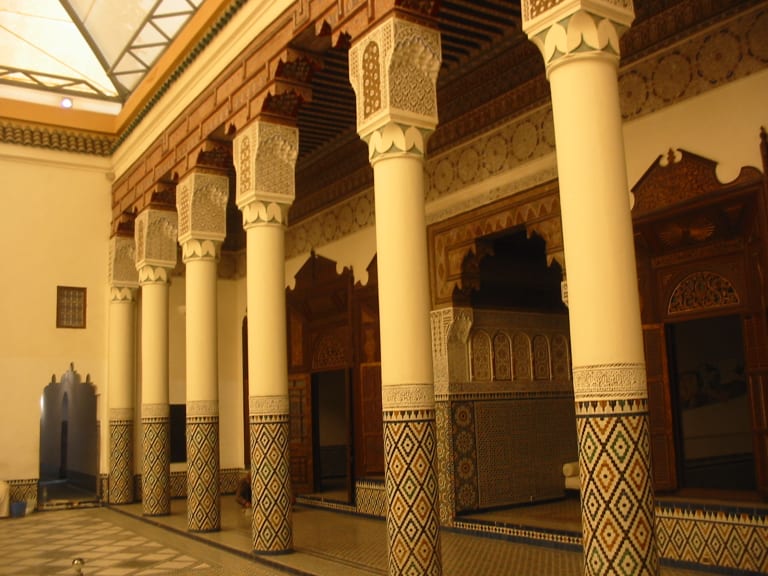More about: Best Things to Do in the Medina of Marrakech
The medina is the name by which the old city of Marrakech is known. From the world's most luxurious accommodation, traditional Moroccan baths or Hammams, to visits to palaces, markets and mosques, there is so much to see and do in the medina of Marrakech!
Surrounded by approximately 19 kilometres of walls built in 1122, the Medina is the name by which the entire historic centre of the city is known; it is the oldest part of the city, also known as the Old City. Until just over 100 years ago, the entire city of Marrakech and its commercial activity were located within these walls.
Lose yourself in the souks of the Medina

For shoppers exploring Marrakech, the souks are the best place to visit in Morocco; getting lost in them is also unavoidable and part of the fun when visiting this vibrant city. What I like most is that the souks of Marrakech offer in one place a complete overview of all the craftsmanship of Morocco, combining age-old talent, culture and tradition in their creations.
Marrakech' s maze of narrow streets are lined with colourful textiles, clothing, pottery, ceramics and jewellery. If you stop at the stalls long enough you will have the opportunity to watch the workers create their beautiful designs. It is common practice to find young apprentices in the workshops with their masters listening repeatedly to the Qur'an as they work on their creations.
As well as Moroccan handicrafts, the souks of Marrakech offer a variety of meats, fruits and vegetables, so don't hesitate too long if you're tempted to try some seasonal fruit. From the architecture to the smells, colours and sounds, you'll feel the place invade every one of your senses - an experience you won't want to miss!
Stroll through the Majorelle Gardens

Jacques Majorelle was a French-born painter who was once so enchanted by the beauty of Morocco that he decided to move here permanently and invest his time and money in creating a beautiful Art Deco-style villa.
Majorelle's paintings, however, focused mainly on depicting local Moroccan life, made him famous in Europe. His most famous work is undoubtedly the fabulous tropical garden filled with cacti, palms and ferns. After the death of its owner in 1962. Le Jardin Majorelle fell into disrepair, the property was recovered and refurbished and opened to the public after being acquired by Yves Saint Laurent himself.
Luxury Accommodation and Hammans

Two of the most prestigious hotels in the world, the La Mamounia Hotel and the Royal Mansour Hotel, are located within the confines of the medina of Marrakech. The most interesting part is that they are completely open to visitors so you can include these stops on your tour.
You can plan a walk to explore the gardens of La Mamounia, take a moment and stop at the café or browse the expensive luxury shops inside. The Royal Mansour hotel, meanwhile, dazzles with its impressive architecture.
As for the traditional hammams, they are scattered throughout the medina; the more modern and luxurious ones offer their guests additional add-ons such as the beauty treatments typical of modern spas and of course massage sessions.
Taste the gastronomic delights of Marrakech
And if you want to immerse yourself in the popular culture of Morocco, don't miss out on a gastronomic tour. This is an experience lasting no less than 3 hours, in which you will be accompanied by an expert guide, with whom you will learn all about the history and local culture of Marrakesh and its markets.
In addition, you will taste a multitude of local products such as olives, dates, Moroccan bread or tea, as well as typical dishes such as kofta.
This experience includes around ten tastings, with which you will end up completely full and satisfied.
Enjoy Djema El Fna after dark

The main square of Marrakech is called Djemaa El Fna and is located in the heart of the medina. The best time to visit it is after sunset. This is when the city takes on a uniquely festive atmosphere.
On your visit to Djemaa El Fna be prepared for an onslaught of interesting experiences with women designing henna tattoos on their bodies, snake charmers, trained monkeys (super smart and friendly) and even acrobats and dancers in the style of Cirque Du Soleil.
The locals who live in the medina take advantage of the spectacular nights to sell just about everything from carpets to clothes, Moroccan food, spices and herbs of all kinds. It's up to tourists to learn their way around the city, weave their way through the many street stalls, soak up the local culture to immerse themselves as much as possible in the frenetic and charged atmosphere of the place.
Be sure to visit the Koutoubia Mosque

No visit to Marrakech would be complete without a stop at the Koutoubia Mosque. Considered the symbol of the city, it is particularly famous for its imposing 70-metre high minaret which can easily be seen from miles away. Built in 1162, it is considered one of the masterpieces of Almohad architecture.
Be aware that, like all the other mosques in the city, entry is forbidden to NON-Muslims. So you will have to make do with admiring the outside view of the beautiful gardens of roses, orange trees and palm trees. A guided tour of Marrakech will include among its stops a visit to this historic monument, a jewel of local architecture.
Visit the Ben Youssef Medersa

The Ben Youssef Medersa is one of the most beautiful buildings in the city and one of the greatest examples of Saadian-era art in Morocco. Located directly opposite the Ali Ben Youssef Mosque, this building was built as a theological school and at its peak it housed 900 students, making it the largest Koranic study centre in the country. A must-see among the many places to see in Marrakesh
The many burrow-like rooms where students once slept are grouped around small internal courtyards, following the typical pattern of architectural layout in Islamic culture. Among the small courtyards is a main internal courtyard that serves as a general common area.
When you visit the Medersa of Ben Youssef, take some time to admire the zellige tiles (a type of handmade tile characteristic of Morocco), the stalactite ceilings, the cedar wood details and the kufic inscriptions used as decoration inside the courtyards.
Enter the Bahia Palace

Although it may seem a modest building from the outside, the architectural richness of the interiors of the Bahia Palace makes it worth a visit on any tour of the medina of Marrakech. The two main attractions are the main marble courtyard and the luxurious salons located in the haram area.
The palace was built at the end of the 19th century as the residence of the Grand Vizier Bou Ahmed, who was then in the service of Sultan Moulay al-Hasan I. Behind its doors you will find rooms with mosaic ceilings and ornate stone carvings, with an exquisite level of detail and taste. The overall interior decoration ultimately results in a display of Moroccan craftsmanship at its finest.
During the hot months, the interiors of the Bay Palace serve as a refuge from the scorching Moroccan heat. The lush interior courtyard of the grand riad is composed mainly of banana-leaf plants and citrus trees, providing a tranquil respite from the Medina's exterior.
Explore the ramparts

As Marrakesh's dominions have extended beyond the walls, a walk along the ramparts is a good way to appreciate and distinguish the contrast between the old and new parts of the city. The wall covers an area of approximately 18 km where you will find more than 20 impressive gates, of which Bab Agnaou is considered the most beautiful.
The walls surrounding the medina of Marrakech were built in the 12th century as a protective wall to guard against external attacks on the people who lived there. Today most of the hotels, riads and traditional restaurants are located within its walls, forming what is known as the old city.
The Moroccans have decided to preserve the wall as an icon of the city and an impressive piece of architecture in its own right. The walls are lined with hedges, gardens and benches that are a good place to rest during your walk.
Explore the Saadian tombs

The Saadi Tombs is the place where more than 100 princes and Sultan Ahmed el Mansour are currently buried. The entire mausoleum is lined with marble stones forming a dazzling interior space. The tombs, covered with shiny tiles, are decorated with elaborate inscriptions. The tomb spaces are exquisitely tasteful with magnificent vaulted chambers bathed in the subtle light of natural lanterns that create a solemn, calm and serene atmosphere inside.
If you visit the Sa'adi Tombs I recommend you arrive early, before 10am, to avoid possible crowds. The entrance fee is approximately €1.
Explore the Museum of Marrakech

Exploring the Marrakech Museum is about much more than art and history. The city's main museum is housed in a 19th century palace of exquisite architecture and design. It has a fascinating art collection made up of traditional artefacts from different Moroccan regions or villages. However, I personally consider the architecture of the museum itself to be an immersive work of art that tourists and locals alike will enjoy.
On your visit to the medina of Marrakech take a moment to embrace the tranquillity and peace of this space. As you stroll between arches and columns millimetrically decorated with colourful mosaics, appreciate Moroccan art up close and don't forget to sip a tasty mint tea in the café.
Get ready for your adventure in the Medina of Marrakech

Before visiting the Medina of Marrakech you should be well prepared, so here are my top tips for travelling to Marrakech. Remember that although Marrakech is a beautiful and exciting city, it is considered one of the main cultural centres not only in Morocco but also in Africa. Ranked among the most visited destinations in the world, its streets are buzzing with activity all day, every day, so get your energy up and enjoy!
Useful tips when visiting the Medina.
Seen from the sky, the Medina resembles a giant honeycomb and the activities inside are almost endless. Here are a few tips for your visit:
- Wear appropriate clothing: Don't forget that 70% of Moroccans are of Arab origin and their culture is very conservative.
- Carry cash: Before entering the markets, make sure you have a few dirhams with you. In most cases you won't be able to use your credit cards for street shopping in the Medina.
- Havea map of the place at hand: or Google Maps for reference.
Consider a guided tour

If this is your first time visiting Morocco, if you have no experience travelling to foreign developing countries, if you are travelling alone and/or if you are not fluent in English or French, one way to feel more confident in Marrakech is to book a guided tour during your first few days in Marrakech
The Medina of Marrakech is a World Heritage Site and a good guide will make your life easier by taking you through the sights and giving you the tips you need to follow the journey on your own. The guide will be especially useful when you visit the souks of Marrakech where it is really easy to get lost even for the locals themselves. In addition, you will be able to express all the doubts you have and learn ways to communicate.
Furthermore, it is essential that you plan a spa morning on your two-day trip to Marrakech or three-day trip to Marrakech.




